
Drosera, which is commonly known as the sundews, is one of the largest genera of carnivorous plants, with at least 194 species. These members of the family Droseraceae lure, capture, and digest insects using stalked mucilaginous glands covering their leaf surfaces. The insects are used to supplement the poor mineral nutrition of the soil in which the plants grow. Various species, which vary greatly in size and form, are native to every continent except Antarctica.

Droseraceae is a family of carnivorous flowering plants, also known as the sundew family. It consists of approximately 180 species in three extant genera, the vast majority being in the sundew genus Drosera. The family also contains the well-known Venus flytrap and the more obscure waterwheel plant, both of which are the only living species of their respective genera. Representatives of the Droseraceae are found on all continents except Antarctica.

Drosophyllum is a genus of carnivorous plants containing the single species Drosophyllum lusitanicum, commonly known as Portuguese sundew or dewy pine. In appearance, it is similar to the related genus Drosera, and to the much more distantly related Byblis.

Drosera capillaris, also known as the pink sundew, is a species of carnivorous plant belonging to the family Droseraceae. It is native to the southern United States, the Greater Antilles, western and southern Mexico, Central America, and northern South America. It is listed as vulnerable in the US state of Virginia, and critically imperiled in Arkansas, Maryland, and Tennessee.

Drosera capensis, commonly known as the Cape sundew, is a small rosette-forming carnivorous species of perennial sundew native to the Cape in South Africa. Because of its size, easy-to-grow nature, and the copious amounts of seed it produces, it has become one of the most common sundews in cultivation, and thus, one of the most frequently introduced and naturalised invasive Drosera species.

Drosera rotundifolia, the round-leaved sundew, roundleaf sundew, or common sundew, is a carnivorous species of flowering plant that grows in bogs, marshes and fens. One of the most widespread sundew species, it has a circumboreal distribution, being found in all of northern Europe, much of Siberia, large parts of northern North America, Korea and Japan but is also found as far south as California, Mississippi and Alabama in the United States of America and in New Guinea.

Drosera spatulata, the spoon-leaved sundew, is a variable, rosette-forming sundew with spoon-shaped leaves. The specific epithet is Latin for "spatula shaped," a reference to the form of the leaves. This sundew has a large range and occurs naturally throughout Southeast Asia, southern China and Japan, Micronesia, Papua New Guinea, eastern Australia, Tasmania and New Zealand. Variants are often known by the localities in which they are found. The plant does not form hibernacula in winter, and is easily grown using the same methods as Drosera capensis.

Drosera regia, commonly known as the king sundew, is a carnivorous plant in the sundew genus Drosera that is endemic to a single valley in South Africa. The genus name Drosera comes from the Greek word droseros, meaning "dew-covered". The specific epithet regia is derived from the Latin for "royal", a reference to the "striking appearance" of the species. Individual leaves can reach 70 cm (28 in) in length. It has many unusual relict characteristics not found in most other Drosera species, including woody rhizomes, operculate pollen, and the lack of circinate vernation in scape growth. All of these factors, combined with molecular data from phylogenetic analysis, contribute to the evidence that D. regia possesses some of the most ancient characteristics within the genus. Some of these are shared with the related Venus flytrap (Dionaea muscipula), which suggests a close evolutionary relationship.

Drosera peltata, commonly called the shield sundew or pale sundew, is a climbing or scrambling perennial tuberous species in the carnivorous plant genus Drosera. Among the tuberous sundews, D. peltata has the largest distribution, which includes eastern and western Australia, New Zealand, India, and most of Southeast Asia including the Philippines. The specific epithet is Latin for "shield shaped", a reference to the shape of the cauline leaves. It is either a single extremely variable species, or a complex of several closely related species of uncertain taxonomic boundaries. In Australia at least four forms have had or still have specific taxonomic recognition: Drosera peltata subsp. peltata, D. peltata subsp. auriculata, D. foliosa and D. gracilis.
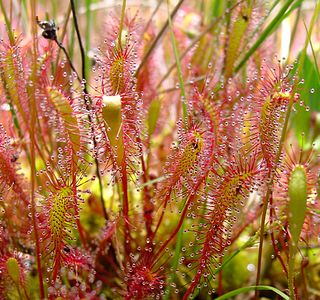
Drosera anglica, commonly known as the English sundew or great sundew, is a carnivorous flowering plant species belonging to the sundew family Droseraceae. It is a temperate species with a circumboreal range, although it does occur as far south as Japan, southern Europe, and the island of Kauai in Hawaii, where it grows as a tropical sundew. It is thought to originate from an amphidiploid hybrid of D. rotundifolia and D. linearis, meaning that a sterile hybrid between these two species doubled its chromosomes to produce fertile progeny which stabilized into the current D. anglica.

Drosera binata, commonly known as the forked sundew or fork-leaved sundew. It is a large, perennial sundew native to Australia and New Zealand. The specific epithet is Latin for "having pairs" - a reference to the leaves, which are dichotomously divided or forked.

Drosera intermedia, commonly known as the oblong-leaved sundew, spoonleaf sundew, or spatulate leaved sundew, is an insectivorous plant species belonging to the sundew genus. It is a temperate or tropical species native to Europe, southeastern Canada, the eastern half of the United States, Cuba, Hispaniola, and northern South America.
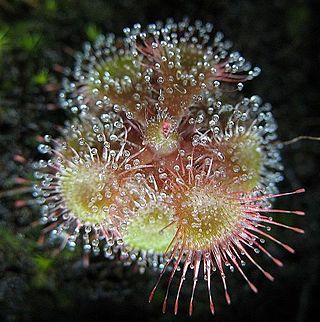
Drosera burmanni, the tropical sundew, is a small, compact species in the carnivorous plant genus Drosera. Its natural geographical range includes the tropical and subtropical regions of Asia and Australia. It normally spans only 2 cm (0.8 in) in diameter. It is one of the fastest trapping sundews as well, and its leaves can curl around an insect in only a few seconds, compared to the minutes or hours it takes other sundews to surround their prey. In nature, D. burmanni is an annual, but in cultivation, when grown indoors during the cold months, it can live for many years. Since D. burmanni is an annual, it produces large amounts of seed. Drosera burmanni has been considered a powerful rubefacient in Ayurveda.
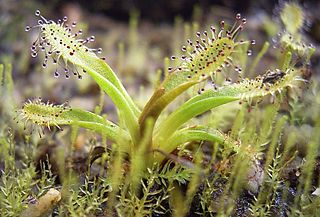
Drosera arcturi is a perennial, insectivorous species of sub-alpine or alpine herb native to Australia and New Zealand. It is one of New Zealand's two alpine species of sundew, the other being Drosera stenopetala. The specific epithet, which translates as "of Arthur" from Latin, is a reference to Mount Arthur, in north-eastern Tasmania, the type locality of the species.
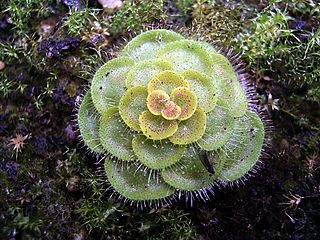
Drosera zonaria, the painted sundew, is a perennial tuberous species in the carnivorous plant genus Drosera and is endemic to south-west Western Australia from near Perth southeast to near Esperance. It grows in a tight rosette approximately 5 to 7 cm in diameter with 20 to 30 green to red leaves that are arranged in concentric layers. The leaves are typically 1 cm wide and are usually described as being "kidney-shaped" with crimson leaf margins. It grows in deep silica sands in open woodland or coastal heathland and only flowers after a bush fire, which is speculated to be caused by the release of ethylene. Its white, sweetly perfumed flowers, which are very similar to those of D. erythrorhiza, emerge on 4 to 5 cm tall scapes. As with most other tuberous Drosera species, D. zonaria will die back during the dry summer months and retreat to the fleshy tuber 10 to 30 cm below ground.

Drosera slackii is a subtropical sundew native to the Cape Provinces of South Africa. It forms rosettes that range from to two to four inches in diameter, and produces pink flowers. It is named after the British plantsman and author Adrian Slack (1933-2018).

Drosera meristocaulis is a perennial species in the carnivorous plant genus Drosera, the only member of the subgenus Meristocaulis. It is a small, rosette- and branched stem-forming sundew that has many morphological affinities to the Australian pygmy sundews. D. meristocaulis is wholly endemic to Pico da Neblina, an isolated mountain on the Brazil-Venezuela border.
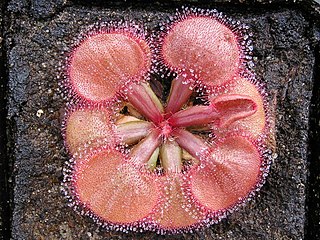
Drosera falconeri is a carnivorous plant in the family of Droseraceae. It is endemic to the Northern Territory of Australia.

Drosera kaieteurensis is a plant from the sundew family (Droseraceae).

Drosera admirabilis, commonly referred to as the "floating sundew", is in the carnivorous us plant family Droseraceae. The nickname "admirabilis" was first used in literature by Paul Debbert in 1987 and was derived from how "admirable" the plant appears when it reaches a fully matured specimen. Structurally similar to Drosera aliciae, and Drosera cuneifolia, the D. admirabilis grows in a single tight rosette-shaped leaf bundle. The leaves widen towards the end and have rounded tips. Leaves lay horizontally under proper lighting conditions. Like many other African sundews, D. admirabilis is a perennial. D. admirabilis has outer tentacles like those of Drosera glanduligera, Drosera sessilifolia and Drosera burmanni which briefly after stimulation bend towards the prey.























